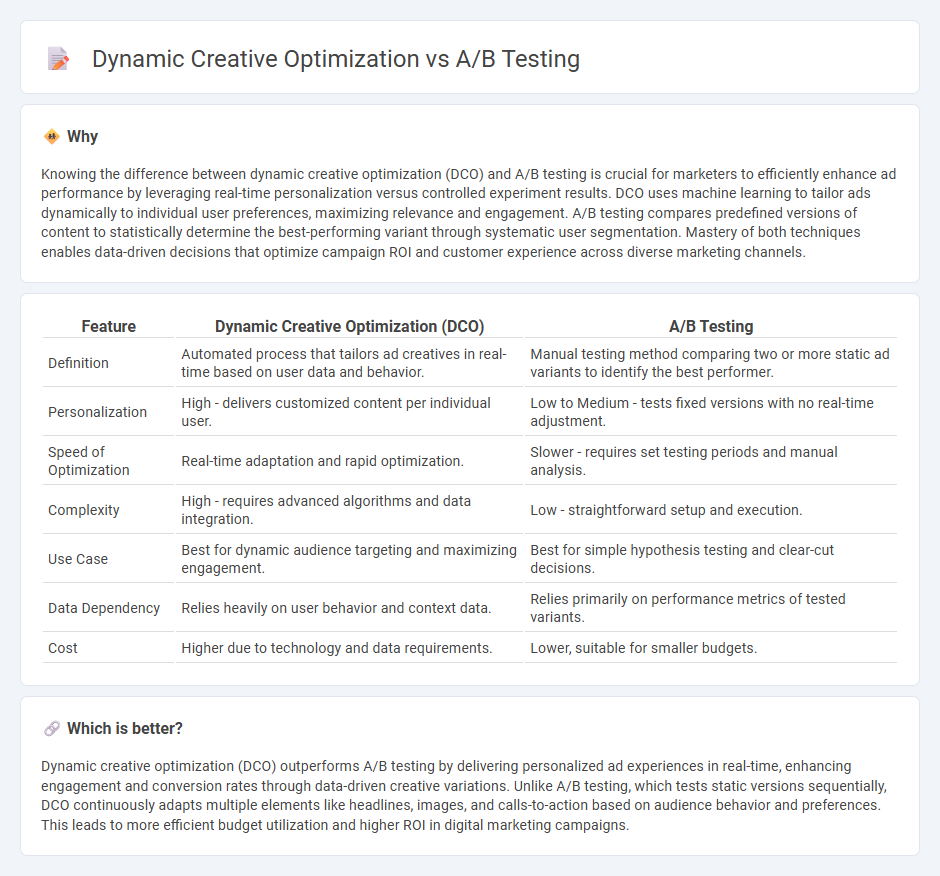
Dynamic Creative Optimization (DCO) leverages real-time data and machine learning to tailor personalized ad content, maximizing engagement and conversion rates beyond static approaches. A/B testing compares two fixed versions of a campaign element to identify the higher-performing option through controlled experimentation. Explore further to understand how these methodologies can elevate your marketing strategy.
Why it is important
Knowing the difference between dynamic creative optimization (DCO) and A/B testing is crucial for marketers to efficiently enhance ad performance by leveraging real-time personalization versus controlled experiment results. DCO uses machine learning to tailor ads dynamically to individual user preferences, maximizing relevance and engagement. A/B testing compares predefined versions of content to statistically determine the best-performing variant through systematic user segmentation. Mastery of both techniques enables data-driven decisions that optimize campaign ROI and customer experience across diverse marketing channels.
Comparison Table
| Feature | Dynamic Creative Optimization (DCO) | A/B Testing |
|---|---|---|
| Definition | Automated process that tailors ad creatives in real-time based on user data and behavior. | Manual testing method comparing two or more static ad variants to identify the best performer. |
| Personalization | High - delivers customized content per individual user. | Low to Medium - tests fixed versions with no real-time adjustment. |
| Speed of Optimization | Real-time adaptation and rapid optimization. | Slower - requires set testing periods and manual analysis. |
| Complexity | High - requires advanced algorithms and data integration. | Low - straightforward setup and execution. |
| Use Case | Best for dynamic audience targeting and maximizing engagement. | Best for simple hypothesis testing and clear-cut decisions. |
| Data Dependency | Relies heavily on user behavior and context data. | Relies primarily on performance metrics of tested variants. |
| Cost | Higher due to technology and data requirements. | Lower, suitable for smaller budgets. |
Which is better?
Dynamic creative optimization (DCO) outperforms A/B testing by delivering personalized ad experiences in real-time, enhancing engagement and conversion rates through data-driven creative variations. Unlike A/B testing, which tests static versions sequentially, DCO continuously adapts multiple elements like headlines, images, and calls-to-action based on audience behavior and preferences. This leads to more efficient budget utilization and higher ROI in digital marketing campaigns.
Connection
Dynamic creative optimization leverages real-time data to automatically tailor ad content for specific audience segments, enhancing engagement and conversion rates. A/B testing complements this by systematically comparing different versions of creatives to identify the highest-performing elements. Together, they enable marketers to iteratively optimize ad effectiveness through data-driven adjustments and personalized messaging.
Key Terms
Split Testing
A/B testing compares two distinct ads to determine which performs better by analyzing specific metrics like click-through rates and conversions, offering straightforward insights for optimizing campaigns. Dynamic Creative Optimization (DCO) tailors ad components in real-time based on user data, enabling highly personalized and adaptive advertising experiences. Explore in-depth strategies and case studies to master split testing and elevate your campaign effectiveness.
Real-Time Personalization
A/B testing compares fixed versions of ads to determine which performs better, while dynamic creative optimization (DCO) tailors ad content in real time by adjusting elements based on user data and behavior. Real-time personalization through DCO enhances relevance and engagement by delivering customized experiences at scale, adapting instantly to audience preferences and contextual signals. Explore deeper insights into how real-time personalization can transform your marketing strategy.
Multivariate Analysis
A/B testing evaluates two or more distinct versions of a single element to identify the highest-performing variant, while dynamic creative optimization (DCO) uses real-time data to tailor multiple creative elements across various audience segments. Multivariate analysis enhances both methods by examining combinations of variables simultaneously, offering deeper insights into how different components influence overall performance. Explore how integrating multivariate analysis with A/B testing and DCO can elevate your campaign optimization strategies.
Source and External Links
What is A/B testing? With examples - A/B testing is a method of comparing two versions of a webpage or app by randomly showing users either the original (control) or a modified (variation) version to determine which performs better based on user engagement and conversion metrics.
A/B testing - Wikipedia - A/B testing is a simple randomized controlled experiment comparing two versions of a single variable, often used to test changes in marketing campaigns or web design by measuring user response to each variant statistically.
A/B Testing 101 - NN/g - A/B testing is a quantitative UX research method where two or more design variations are tested with live users and metrics are measured to identify which design better supports business goals, typically changing one design element at a time for clarity.
 dowidth.com
dowidth.com